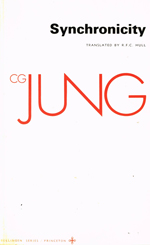Summary
Jung sees synchronicity as a meaningful coincidence in time, a psychic factor which is independent of space and time. This revolutionary concept of synchronicity both challenges and complements the physicist's classical view of causality. It also forces a basic reconsideration of the meaning of chance, probability, coincidence and the singular events in our lives. [1]
Jung was intrigued from early in his career with coincidences, especially those surprising juxtapositions that scientific rationality could not adequately explain. He discussed these ideas with Albert Einstein before World War I, but first used the term synchronicity in a 1930 lecture, in reference to the unusual psychological insights generated from consulting the I Ching . A long correspondence and friendship with the Nobel Prize-winning physicist Wolfgang Pauli inspired a final, mature statement of Jung's thinking on synchronicity, originally published in 1952 and reproduced in this book. Together with a wealth of historical and contemporary material, this essay describes an astrological experiment Jung conducted to test his theory. Synchronicity reveals the full extent of Jung's research into a wide range of psychic phenomena. [2]
This page is based on this
Wikipedia article Text is available under the
CC BY-SA 4.0 license; additional terms may apply.
Images, videos and audio are available under their respective licenses.
